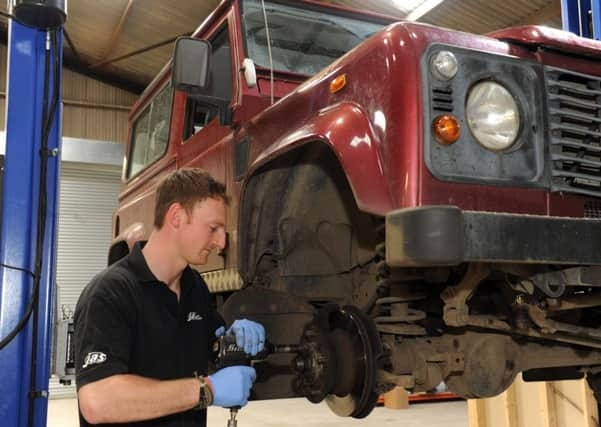New model on four wheels to hit the farm


A new model that complies with all safety standards will be launched soon. However, in the face of Japanese and American competition taking large slices of what once seemed Land Rover’s very own specific territory where does the Defender or its new replacement fit for farmers today?
Joe Hodgson and his partner Steph Lewis started their own servicing and repairs business JAS Land Rovers from his parents’ farm at Everingham, near Shiptonthorpe just over a year ago. Joe had his first Defender at just 17. He has fixed them at a safari lodge in Zambia, has worked in garages in Germany and in Maidenhead, and knows each model inside out.
Advertisement
Hide AdAdvertisement
Hide Ad“I knew nothing about them when I was in my teens other than I wanted one, like every other farmer’s son I guess. I had a 1985 Land Rover 90 that did 0-60 in one minute 32 seconds and was always breaking down, but I soon learned that if you could fix an old Land Rover you could fix any old car. It shaped my career.”
Anyone who had their first experience of a Land Rover Defender a decade or two ago will recall them as boneshakers. It’s a stigma that Joe feels has hopefully finally been shaken off.
“The Defender has been improved so much since 2005. NVH, which is how the manufacturers term noise, vibration and harshness, saw the Defender make an incredible jump forward a decade ago and it has since improved further. When Ford bought Land Rover they brought out a new range of in-house engines in 2007 and also came up with new interiors. The engines are now much smoother running, faster and they have also soundproofed the interior quite substantially.”
But farmers are no longer turning to Defenders in the droves they once were. Instead they are more likely to have a Range Rover or Land Rover Discovery 4 than the archetypal farm vehicle, and more for leisure than as a workhorse. Instead many have turned to the likes of the Hyundai, Nissan, Toyota, Suzuki and others, along with quad bikes.
Advertisement
Hide AdAdvertisement
Hide Ad“I’d say that the market share of farmers that have Defenders is now more like 20 per cent. That means there are still many that have them but they are more typically purchasing a cheaper Japanese pickup instead. When it comes down to making a choice farmers are businessmen and if they can get cheaper and what they may consider as better that’s where they go.
“The market for the Defender today has shifted massively and it is selling brilliantly. If you go down to London nearly every one you will see is a brand new, shiny machine and some even have the spray-on mud, which seems a bit pointless to me but they like it.
“There’s a current trend in making your Defender, if it’s not a farm vehicle, into something that people now refer to as ‘pimped’ with lots of extra bits. The new Defender or whatever it is to be called will address historic issues such as having nowhere to rest your arm against while driving but more importantly it will conform with crash safety regulations such as air bags and rollover protection.”
Despite the shift in farmers buying the Defender there is still the feeling amongst those who have remained faithful to the model that it will run forever. Joe believes that is still the case but that care is needed.
Advertisement
Hide AdAdvertisement
Hide Ad“If you abuse it then don’t expect it to last. If bushes wear out and things start knocking and banging they need to be replaced. These days you generally know when there is any fault coming up because your dashboard tells you. The reason why your suspension will lower is because the vehicle really wants you to stop and get it sorted otherwise it could cost you a great deal.
“Diagnostic kits are now absolutely essential. We just couldn’t do our job without them. We’re currently looking at investing in the latest diagnostic kit which costs around £10,000 and a further £1,000 a year for additional support and updates.”
Joe believes the future for Land Rover is particularly bright.
“The new model replacing the Defender will open up the American market, which they haven’t been able to sell into because of it not conforming to US safety regulations for many years - and the newest Range Rover, well, that’s absolutely spectacular.”